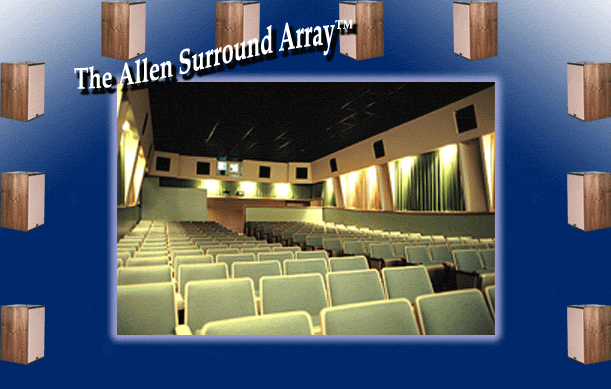 |
|||
| The primary function of a surround array is to provide a uniform sound field around an audience with tone matching the screen channels and without single point localization or other directional cues. Historically the surround arrays installed in movie theatres have generally failed to meet most, if not all, of these goals. Directional cues are common. Patrons are forced to localize to the surround speaker that they are closest to. This is not only the exact opposite of what a surround effect is supposed to be, it is also irritating. Some have even described this effect as being assaulted. Approaches to surround speaker placements have varied as widely as they have failed. At first, inexpensive and small single cone speakers were placed on the walls around the room with no formulas for placement. Later it was suggested that this approach be updated with lots of such small speakers placed as close as a few feet apart. Still, there was no thought as to the appropriate locations, let alone the quality of such speakers. The number of speaker sources was increased, but their sound quality remained low.. In the past 40 years, things have improved. Better speakers have been offered for surrounds. But the type of the speakers used are often completely different from those behind the screen: direct radiators vs. horn loaded systems. Tone matching is poor. In addition, the lack of a serious design approach to their placement has remained. Indeed, one major speaker company once published a paper stating that after decades of trying, “there are no sure fire formulas for locating surround speakers.” Other mistakes are common in surround systems. One is series parallel wiring. One manufacturer claimed that surround speakers should always be wired in series parallel groups of four. Surround arrays have often been under powered increasing the likelihood of speaker failure. In recent years the idea of simply adding lots of speakers has returned. The goal of a uniform surround field throughout the room seem to have been abandoned in favor of concentrating on a smaller so called sweet spot somewhere in the middle of the seats. Manufacturers of loudspeakers have loved this as it sells lots of speakers. But it is an abuse of their customers and of audiences as the speakers are placed so that patrons localize to the group of speakers they are closest to, rather than only one. The ALLEN SURROUND ARRAY™ is a purely mathematical and geometric approach to locating the surround speakers in a motion picture theatre. Unlike any other known method, it matches certain aspects of the speaker’s radiating patterns to the exact dimensions of the room. Employing the minimum number of speakers required, coverage is uniform with no single speaker localization. It has never failed. Without the need for equalization, the SR-70 surround speakers match the sound of the screen so well that some have commented that they could not hear them even when they were playing loud. Surround speakers have been used in motion picture theatres since 1940. However, until the introduction of the HPS-4000® sound system there had never been a scientific approach to the actual placement of the surround speakers around an auditorium. Even today, surround speakers are placed around a theatre with little or no regard to their ultimate function, except perhaps that they should be between the light fixtures. High Performance Stereo™ was the first to develop reliable formulas for the exact placement of the all important surround speakers. These proprietary formulas work because they relate the radiating patterns of the surround speakers themselves to the actual shape of the individual theatre. |
|||